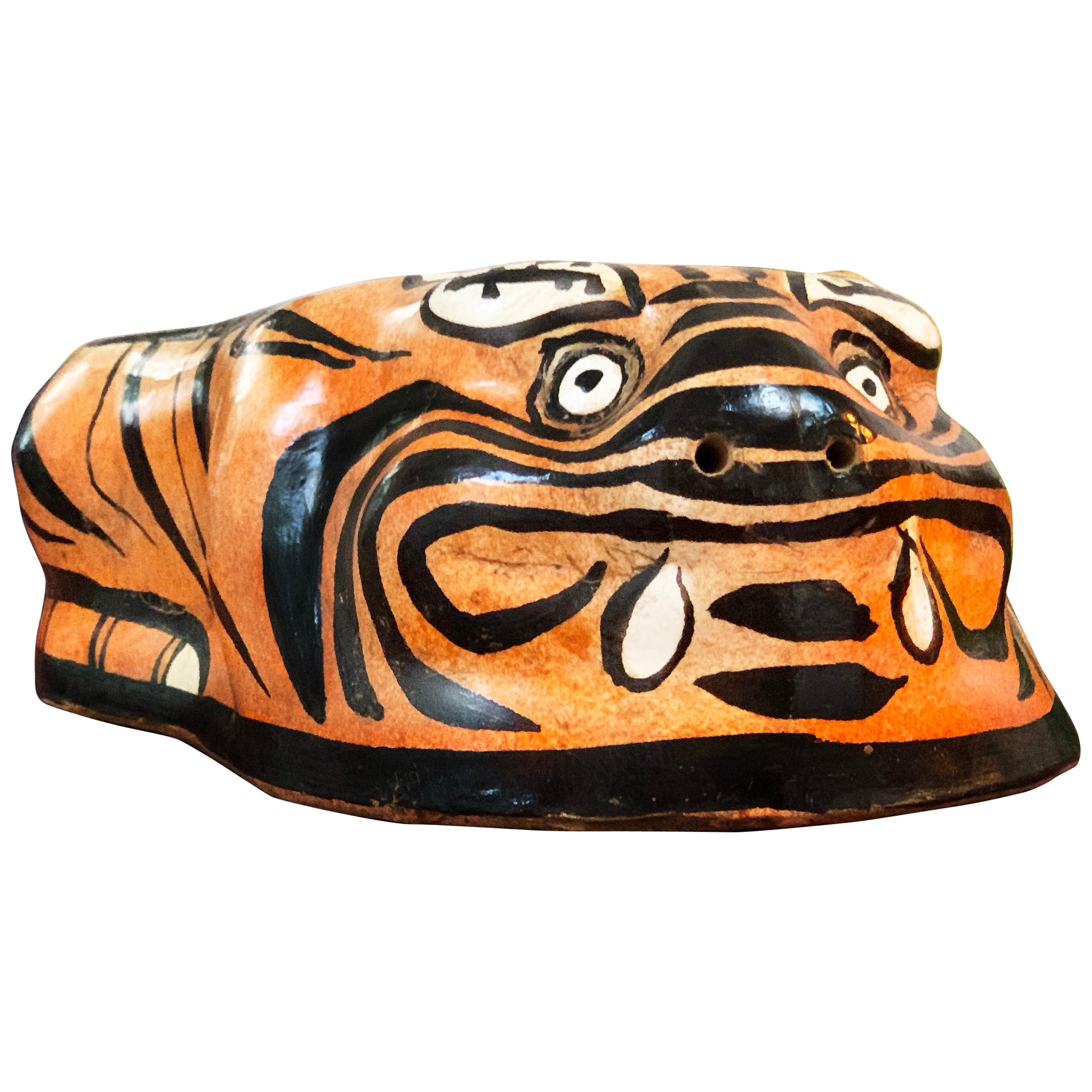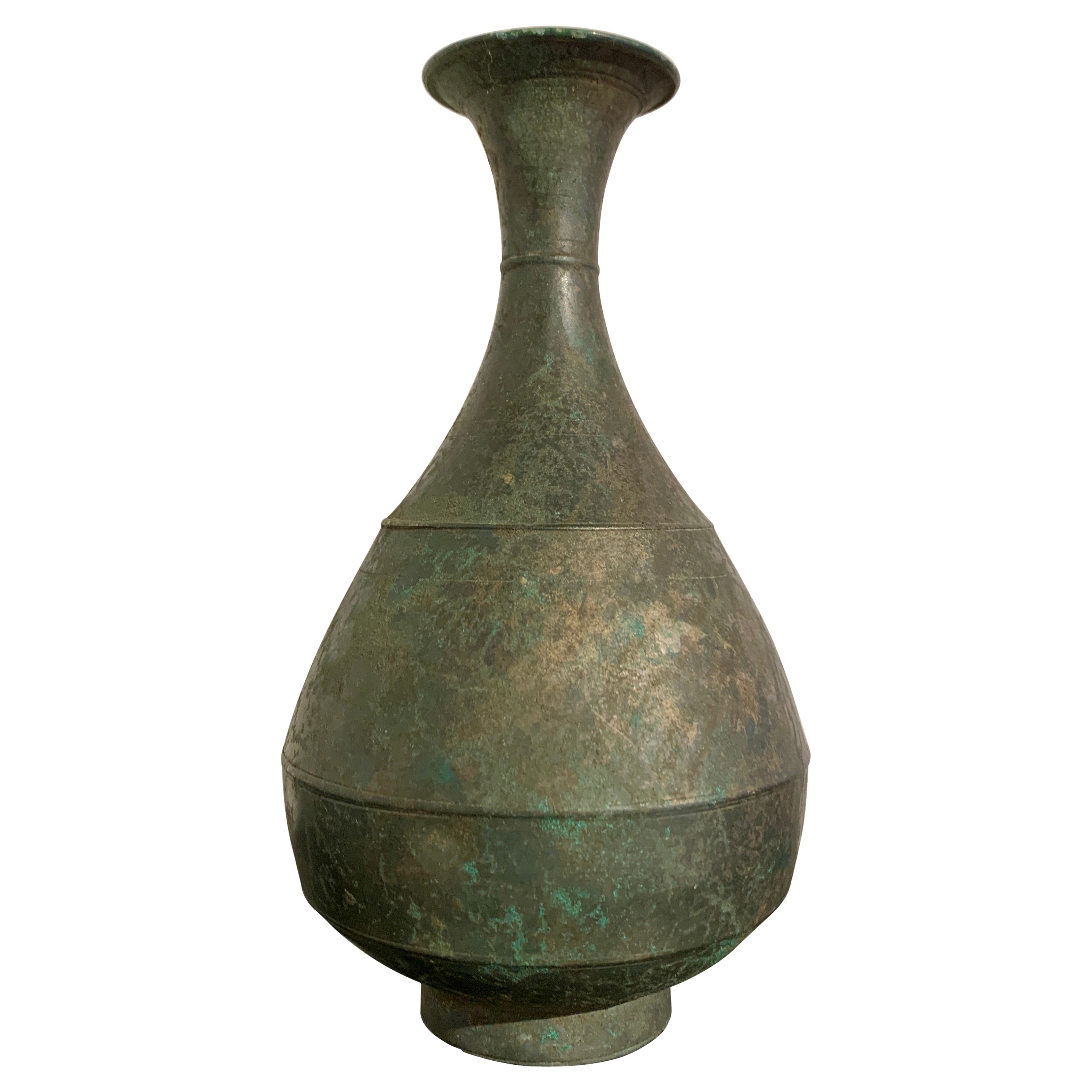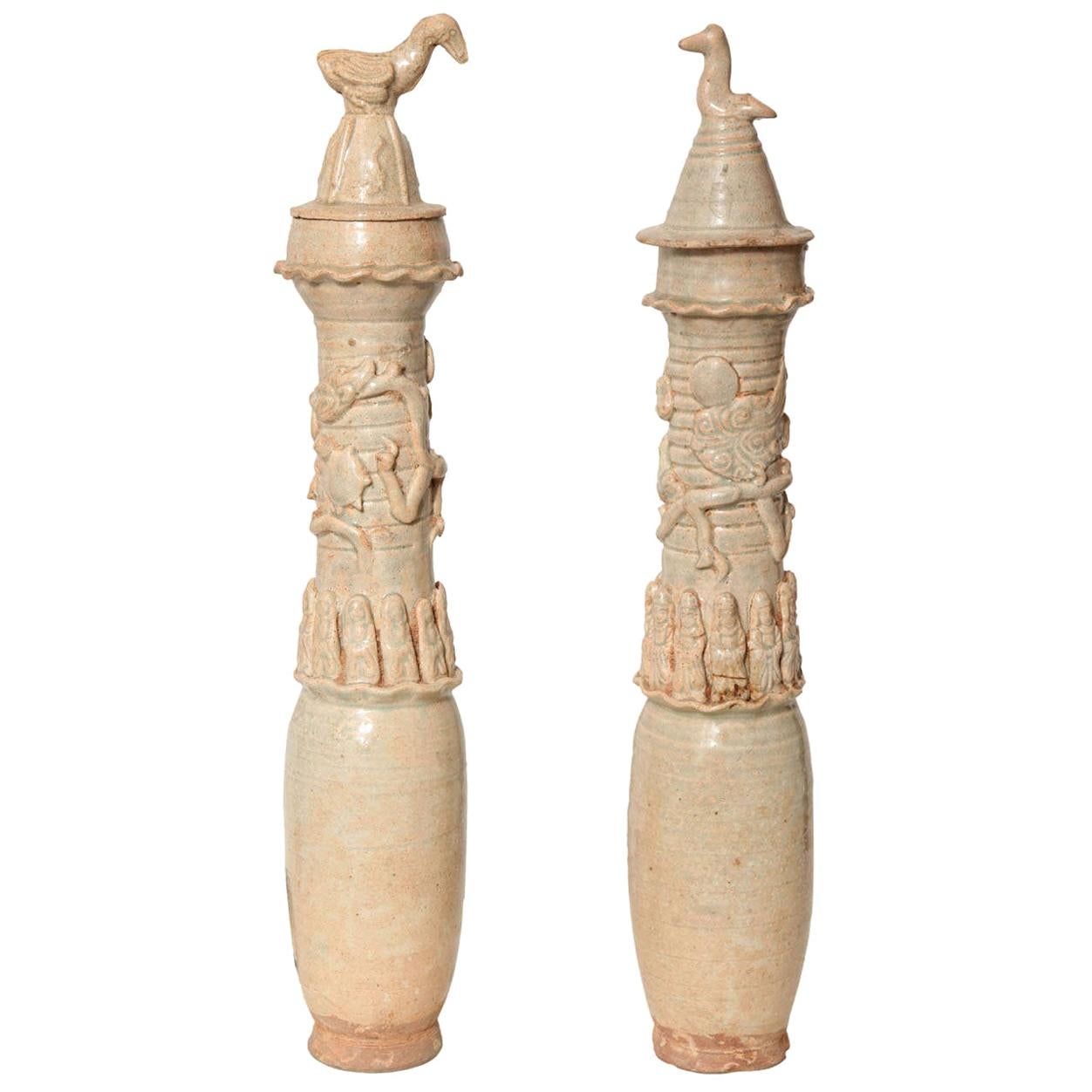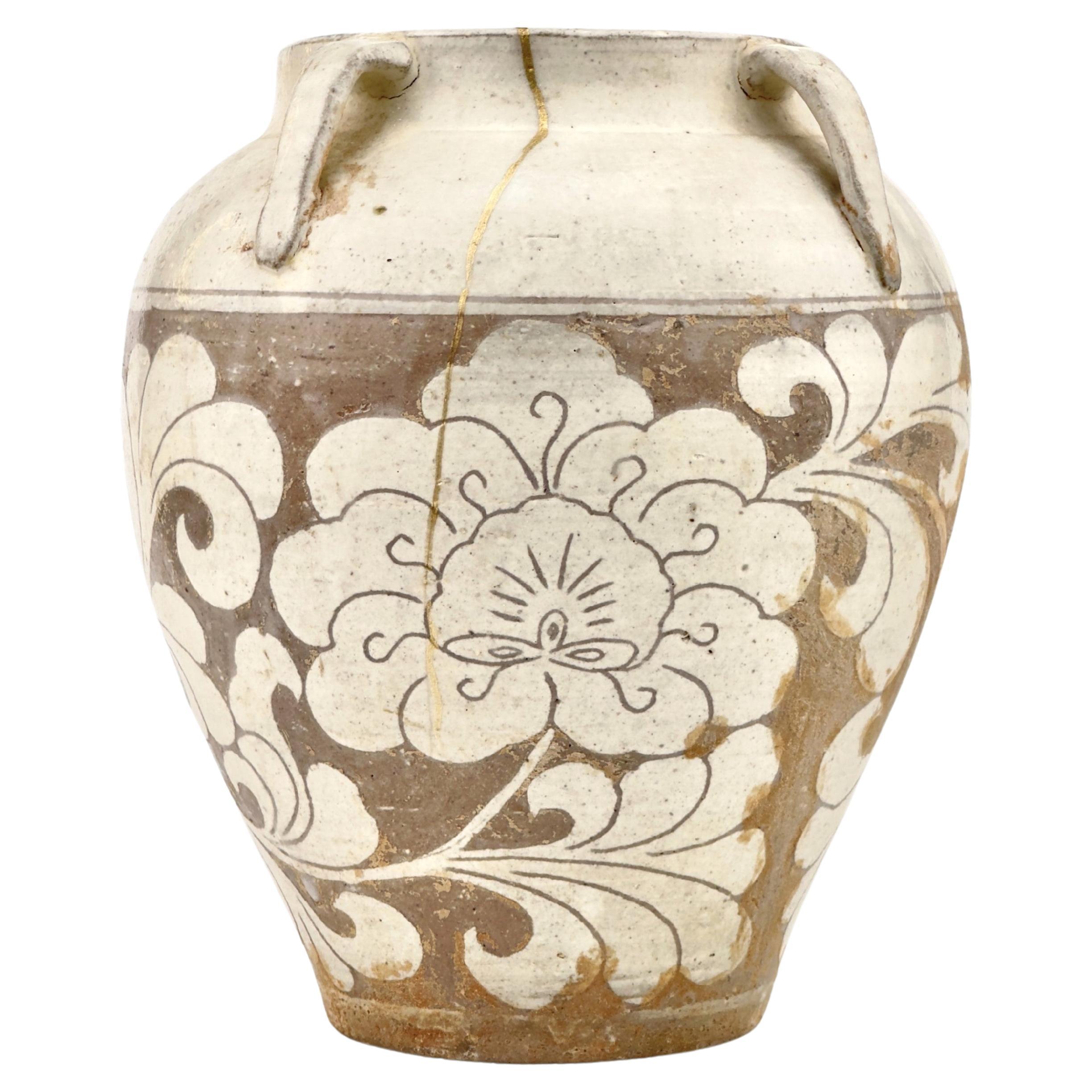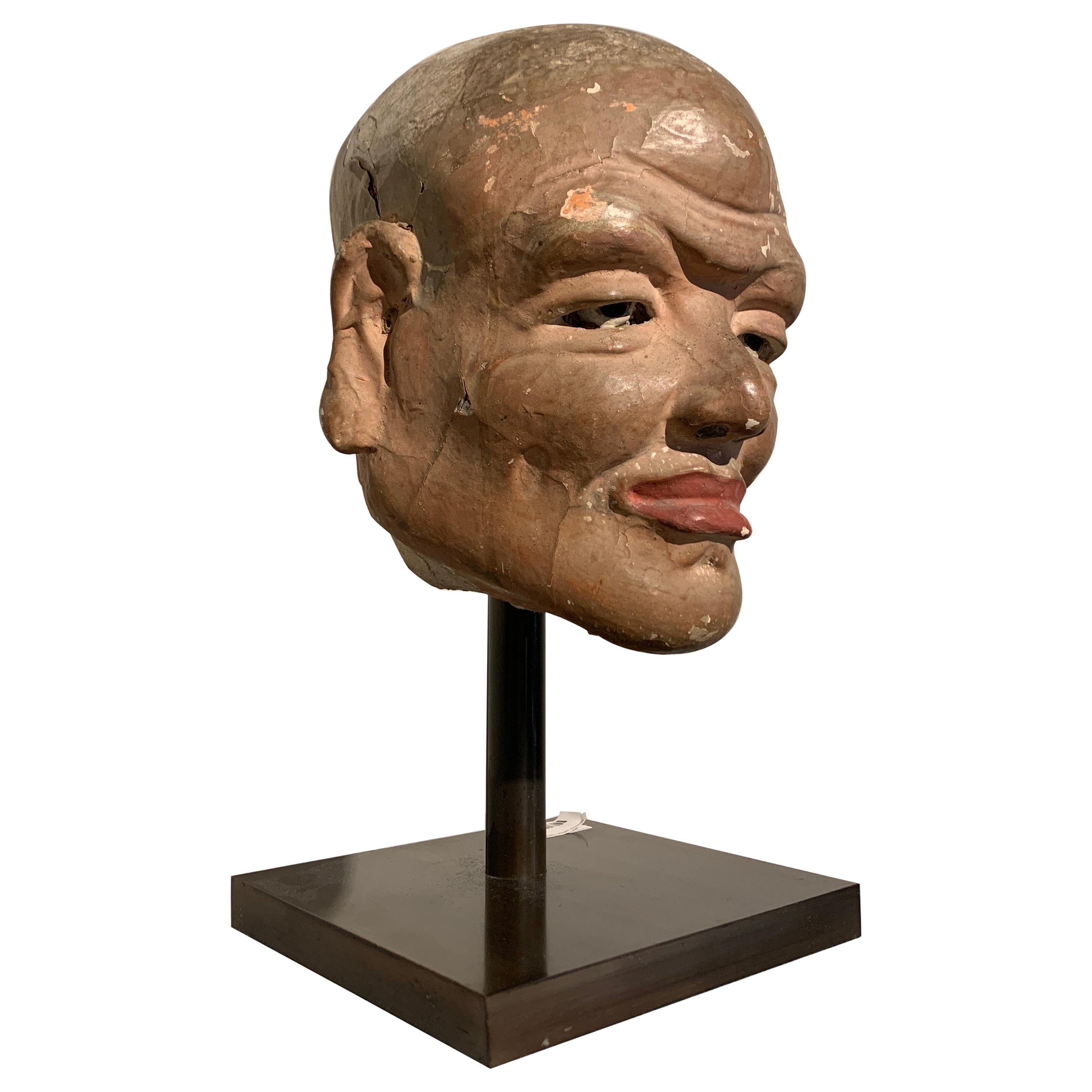Items Similar to Cizhou carved bean-shaped pillow, Song-Jin Dynasty, 11th-12th century
Want more images or videos?
Request additional images or videos from the seller
1 of 15
Cizhou carved bean-shaped pillow, Song-Jin Dynasty, 11th-12th century
About the Item
Crafted from fine clay, the pillow's surface boasts a sophisticated carved design featuring a floral motif that is both symmetrical and organic. The interplay of the earthy tones and the creamy white slip beneath reveals the intricate craftsmanship involved in its creation. This dual-tone effect was achieved through the sgraffito technique, where the top layer of slip is carved to expose the contrasting clay body underneath.
The form of the pillow, with its rounded edges and smooth contours, not only exemplifies the aesthetic values of the period but also illustrates the practical considerations of comfort and function in everyday objects of the time.
A piece like this would not only serve as a functional item in daily life but also as a decorative element, displaying the owner's sophisticated taste and the cultural importance of art in domestic life during the Song-Jin dynasty.
Period : Song-Jin Dynasty, 11th-12th Century
Type : Pillow
Medium : Cizhou Ware
Provenance : Acquired in 1999, Hongkong
Reference :
1) Bonhams London 2 NOVEMBER 2020 Asian Art - Lot 349
(Price : 3,000-4,000 GBP / Type : Closely related)
* Cizhou Ware
Cizhou is the name given to a number of stonewares, grey or buff, of varying degrees of hardness, with painted, incised or carved decoration on a clay slip. These stonewares were not only made in the region of Cizhou, Hebei Province, but in several provinces of China during the Song, Yuan and Ming periods. The great centres of production were in the north of China in the provinces of Hebei, Henan and Shanxi.
Cizhou wares seem to have been very popular, made for a clientèle of rich merchants, at a period when the paintings of famous artists adorned the walls of tea houses of the capital. While this type of pottery did not apparently attract Chinese collectors of the 18th and 19th centuries, it was much appreciated by the Japanese as a kind of folk art, for its rustic look. Nowadays Cizhou fetch very high prices at public auctions.
In the past fifty years, kilns producing Cizhou wares have been identified and excavated. This has made it possible to know the exact origin of certain types and to study the evolution of the ware.
Song potters used several methods of decorating Cizhou: vases, jars, pots, boxes and pillows. Champleve decoration appears at the beginning of the Song period in Henan at Dengfengxian and at Xiuwu. This method consisted of covering the vessel with a white slip, then carving and incising the design as to expose the brown of the body below. The whole surface was then glazed. After firing, the brown of the body formed a striking contrast with that of the glaze covering the white slip. Sometimes the design stands out against a ground of little circles stamped with a metal or bamboo tool. This decoration was often used on Tang metalwork. A variant of the technique used in the 11th century consisted of incising the little circles through the slip, then filling the lines with brick-red paint. The object, generally a pillow or cup, was then glazed. In another type of decoration called sgraffito, two layers of slip were placed one over the other, a brown slip, for example, over a white one, or vice versa over the parts destined for decoration; then the design was drawn by incising and scratching the upper layer, and the whole thing was covered with a transparent glaze.
Reference : Irv Graham
- Dimensions:Height: 5.52 in (14 cm)Diameter: 10.24 in (26 cm)
- Style:Chinoiserie (Of the Period)
- Materials and Techniques:Stoneware,Glazed
- Place of Origin:
- Period:
- Date of Manufacture:11th-12th century
- Condition:Minor fading.
- Seller Location:seoul, KR
- Reference Number:1stDibs: LU9577237780092
About the Seller
New to 1stDibs
Joined in the past six months.
4.5
Vetted Seller
These experienced sellers undergo a comprehensive evaluation by our team of in-house experts.
Established in 1999
1stDibs seller since 2023
Typical response time: 1 hour
- ShippingRetrieving quote...Ships From: seoul, Korea South
- Return PolicyA return for this item may be initiated within 10 days of delivery.
More From This SellerView All
- Celadon Vase, Five Dynasties or Northern Song dynasty, 10th-11th CenturyLocated in seoul, KRThe form of Longquan celadon vases from the Northern Song dynasty evolved from an early design with a long neck and tapering body to a later ovoid body with a shorter neck. Over time, the glaze developed a more olive tone, and the carved decorations became more pronounced and intricate. Examples of such vases include one without a cover dated to the Yuanfeng era (1078~1085) and documented in literature, and another similar vase without loop handles preserved by the Qingyuan County Cultural Relics Bureau. An earlier example featuring loop handles and a lotus-like cover is also mentioned in historical texts. The use of Longquan covered vases, especially as funerary jars for offerings like wine and grains, was highlighted by an inscription on a piece from the Sir Percival David Collection, London. This inscription wishes for the vessel to preserve fragrant wine for centuries, blessing the owner with prosperity, longevity, and a vast lineage, dated to the third year of the Yuanfeng period (1080). This practice was common in the regions of Southern Zhejiang and Northern Fujian. A similar celadon vase from the Linyushanren collection was auctioned at Christie’s Hong Kong, emphasizing the cultural and historical significance of these artifacts. Period : Five Dynasties or Northern Song Dynasty Type : Celadon, Zhejiang province Medium : Celadon Size : 31.5 cm(Height) x 11.5(Diameter) Provenance : Acquired in late 1990s from Hongkong Reference : 1) The British Museum image id - 01613270570 2) Christies New York 23–24 MAR 2023 - Important Chinese Ceramics and Works of Art - Lot 1012 (Price Range : USD 18,000 – USD 25,000 / Type : Related) 3) National Gallery of Victoria - Accession Number - AS5-1973 * Celadon from Five Dynasties (907~960) to the early Northern Song Dynasty (960~1127) The period from the Five Dynasties (907~960) to the early Northern Song Dynasty (960~1127) marked a significant transitional phase in the development of Chinese celadon ceramics...Category
Antique 15th Century and Earlier Chinese Ming Antiquities
MaterialsCeladon
- Cizhou Lotus Carved Jar, Song-Yuan dynastyLocated in seoul, KRThis jar features a carved design, which is typical of Cizhou ware. It has a creamy white and brown color scheme, and the prominent decoration of lotus flower, which is a common motif in Chinese art and culture, symbolizing purity and enlightenment. The carving technique involves coating the vessel with a layer of white slip (liquid clay), then carving away parts of it to create the design, revealing the darker clay body beneath. This technique allows for a strong contrast between the background and the carved motif. Period : Song-Yuan Dynasty Type : Jar Medium : Cizhou Ware Size : 21.5 cm(Height), 11cm(Mouth Diameter) Provenance : Acquired in 1999, Hongkong * Cizhou Ware Cizhou is the name given to a number of stonewares, grey or buff, of varying degrees of hardness, with painted, incised or carved decoration on a clay slip. These stonewares were not only made in the region of Cizhou, Hebei Province, but in several provinces of China during the Song, Yuan and Ming periods. The great centres of production were in the north of China in the provinces of Hebei, Henan and Shanxi. Cizhou wares seem to have been very popular, made for a clientèle of rich merchants, at a period when the paintings of famous...Category
Antique 15th Century and Earlier Chinese Ming Antiquities
MaterialsPottery
- Cizhou Rectangular Pillow with Carved Decoration, Yuan DynastyLocated in seoul, KRCizhou ware is known for its robust forms and freely applied decoration, often featuring a white slip under clear glaze. The pillow is rectangular, with a slightly curved top surface...Category
Antique 15th Century and Earlier Chinese Ming Antiquities
MaterialsPottery, Stoneware
- A Cizhou Yuhuchunping, Yuan DynastyLocated in seoul, KRThis piece has a flared neck and a globular body, typical of the forms seen in Cizhou ware. The body is decorated with freely drawn floral motifs and abstract patterns, which may inc...Category
Antique 15th Century and Earlier Chinese Chinese Export Antiquities
MaterialsStoneware
- A Rare Moulded Dingyao 'Cranes And Fishes' Bowl, Northern Song - Jin DynastyLocated in seoul, KRThis bowl stands out for its detailed depiction of two fish amid soft spiral waves, bordered by two cranes within the bowl. The design's depth and clarity, from the lifelike portraya...Category
Antique 15th Century and Earlier Chinese Ming Antiquities
MaterialsCeramic, Porcelain
- Cizhou slender meiping, Yuan DynastyLocated in seoul, KRThe elongated body is fluidly painted in brown on a white slip and under a clear glaze with a broad band of abstract floral scroll between a band of upright petals below and further ...Category
Antique 15th Century and Earlier Chinese Other Antiquities
MaterialsStoneware
You May Also Like
- Jin Dynasty Cizhou Ware Crouching Tiger Pottery Pillow, 12th-century, ChinaLocated in Brooklyn, NYChinese Jin Dynasty 12th Century Cizhou Ware Crouching Tiger Pottery Pillow .Tiger pillow, Jin dynasty, 12th century (circa 1150) The pillow is assembled ...Category
Antique 15th Century and Earlier Chinese Ming Antiquities
MaterialsCeramic
- Korean Bronze Bottle Vase, Goryeo Dynasty, 11th/12th Century, KoreaLocated in Austin, TXAn attractive Korean Goryeo Dynasty bronze bottle vase with traces of gilding, 11th - 12th century, Korea. The vase of typical form, with a short recessed foot supporting a pear s...Category
Antique 15th Century and Earlier Korean Metalwork
MaterialsBronze
- Antique Ceremonial Urns, Song Dynasty, 12th-13th CenturyLocated in New York, NYTwo tall ceremonial urns dating from the 12th-13th century, Southern Song dynasty. These two stunning vases depict 12 traditional ritual attendan...Category
Antique 15th Century and Earlier Chinese Other Antiquities
MaterialsCeladon
- Chinese Painted Stucco Head of a Luohan, Song Dynasty, 11th Century, ChinaLocated in Austin, TXA remarkable Chinese life sized painted stucco head of a luohan, Song, Liao or Jin Dynasty, circa 11th century, China. The amazingly life-like figure depicts a luohan (sometime spelled lohan), also known as an arhat, one of the original disciples of the Buddha. The elderly man has been molded in stucco with inset glass eyes and painted with idealized, if slightly exaggerated features. The unidentified luohan sports a bald, or perhaps shaved, domed head above a bulging forehead, symbolizing his vast wisdom. The wrinkles in his furrowed brow, and creases around his eyes add to his realism. The learned man stares out wisely from deep set, heavily lidded inlaid glass eyes that catch the light. The luohan has high cheekbones and a prominent jawline. His lips full and pursed as if about to speak. The corners of his mouth turned up ever so slightly in a faint smile, causing his gaunt cheeks to dimple charismatically. A series of dots above the upper lip indicate he may originally have sported a mustache of real hair. This life sized head with extremely realistic features fits into a very narrow time frame of Chinese Buddhist art. Perhaps the most recognized group of large, finely molded Chinese luohan...Category
Antique 15th Century and Earlier Chinese Sculptures and Carvings
MaterialsGlass, Stucco
- Chinese Liao Dynasty Amber Glazed Stoneware Strap Handle Ewer, 11th CenturyLocated in Austin, TXA lovely Chinese amber glazed pottery pouring vessel, Liao Dynasty (907 to 1125 AD). The vessel featuring a globular body with an elongated neck sligh...Category
Antique 15th Century and Earlier Chinese Tang Ceramics
MaterialsStoneware
- Khmer Sandstone Buddha Shiva Head 11th CenturyLocated in Dallas, TXA sandstone figure head of Shiva Khmer, Baphuon style, circa 11th century. A rare Khmer gray sandstone head of Shiva. The handsome head of the divinity deity Shiva. His face with serene expression, almond-shaped eyes, ridged eyebrows and elongated earlobes, His headdress in tight rows and piled in tresses at the top of the head. Provenance: From a Canadian auction selling the estate of a French gentleman who amassed a large collection of Gandhara, Buddhas and Khmer items throughout his life. Measures: Head: 8 x 4.5 x 4.5 inches (20.5 x 11.4 x 11.4 cm) With stand: 10.7 inches tall Similar to item at Christies SALE 2828, Lot 1124 Indian and Southeast Asian Art 19, March 2014, New York. Shiva ( Siva, lit. the auspicious one) also known as Mahadeva ( lit. the greatest god) is one of the principal deities of Hinduism. He is the Supreme Being within Shaivism, one of the major traditions within contemporary Hinduism. Shiva is known as "The Destroyer" within the Trimurti, the Hindu trinity that includes Brahma and Vishnu. In Shaivism tradition, Shiva is the Supreme being who creates, protects and transforms the universe. In the tradition of Hinduism called Shaktism, the Goddess, or Devi, is described as supreme, yet Shiva is revered along with Vishnu and Brahma. A goddess is stated to be the energy and creative power (Shakti) of each, with Parvati (Sati) the equal complementary partner of Shiva. He is one of the five equivalent deities in Panchayatana puja of the Smarta tradition of Hinduism. According to the Shaivism sect, the highest form of Shiva is formless, limitless, transcendent and unchanging absolute Brahman,[16] and the primal Atman (soul, self) of the universe. There are many both benevolent and fearsome depictions of Shiva. In benevolent aspects, he is depicted as an omniscient Yogi who lives an ascetic life on Mount Kailash[1] as well as a householder with wife Parvati and his two children, Ganesha and Kartikeya. In his fierce aspects, he is often depicted slaying demons. Shiva is also known as Adiyogi Shiva, regarded as the patron god of yoga, meditation and arts. The iconographical attributes of Shiva are the serpent around his neck, the adorning crescent moon, the holy river Ganga flowing from his matted hair, the third eye on his forehead, the trishula or trident, as his weapon, and the damaru drum...Category
Antique 15th Century and Earlier Asian Antiquities
MaterialsSandstone
Recently Viewed
View AllMore Ways To Browse
Kiln Pillow
Japanese Covered Jar
Song Dynasty Jar
Cizhou Ware
Ming Dynasty Vessel
Brown Glazed Chinese Jar
Chinese Cizhou Ware
Brushed Copper Ornament
Han Dynasty Green
Design Amsterdam
Office Furniture Suite
Pair Of 20th Century Armchairs
Living Room Divider
Doris Blau Rugs
Bronze Box
Danish Signed Chair
Vintage Midcentury Cocktail Table
Table Lamp Bronze France
